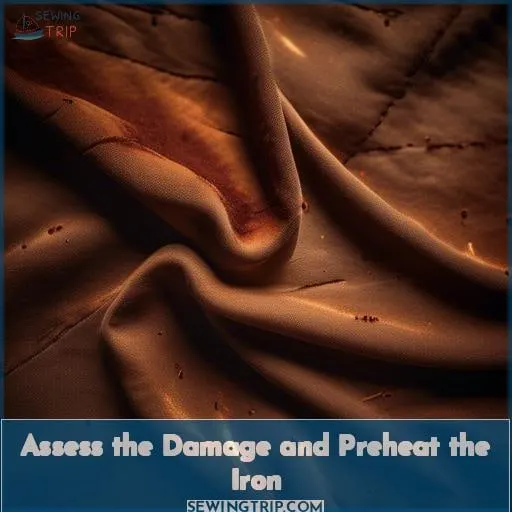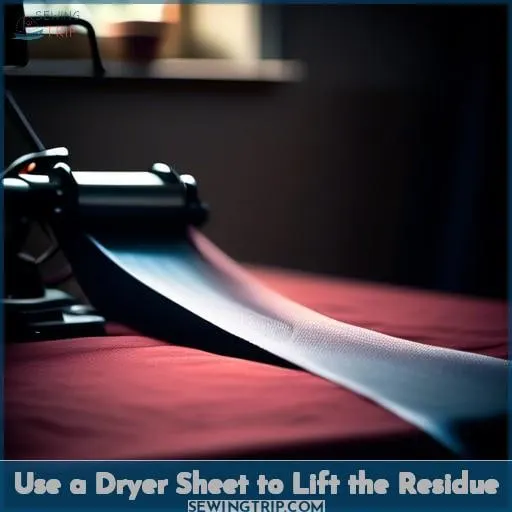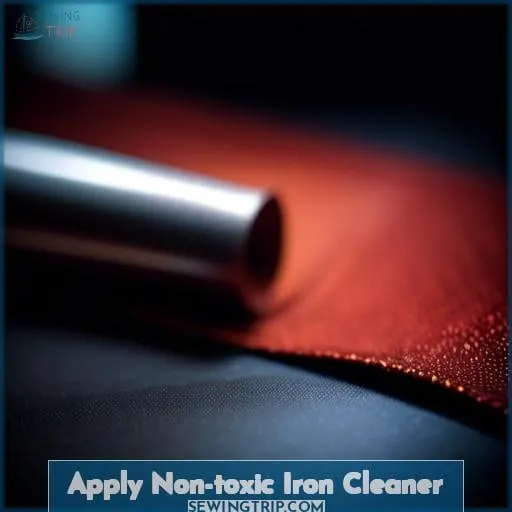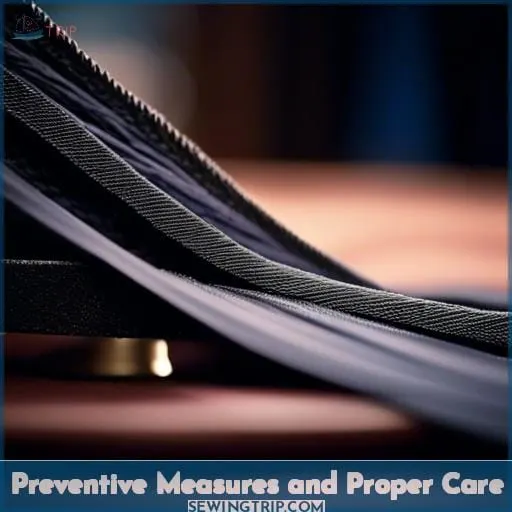This site is supported by our readers. We may earn a commission, at no cost to you, if you purchase through links.
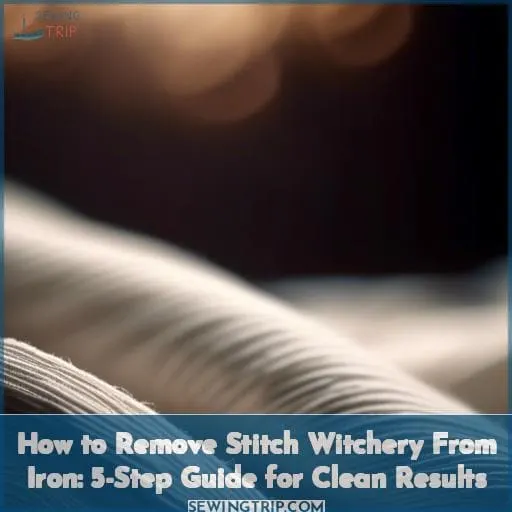 Nearly 90% of sewers have experienced the frustration of fusible interfacing or hemming tape like Stitch Witchery bonding to their iron at some point.
Nearly 90% of sewers have experienced the frustration of fusible interfacing or hemming tape like Stitch Witchery bonding to their iron at some point.
If you’re among them, don’t despair. Removing Stitch Witchery from your iron can be straightforward with the right approach. This guide will walk you through a five-step process to restore your iron’s clean, smooth surface, ensuring your sewing projects remain unmarred by unwanted residue.
From household remedies to specialized cleaners, you’ll learn how to tackle the mess and prevent future mishaps.
Yes, you can remove Stitch Witchery from an iron. Heat the iron and rub it over a crumpled terry towel with pressure, or use a dryer sheet to gently clean the residue off.
Table Of Contents
Key Takeaways
- Use a used dryer sheet to rub over the warm soleplate of the iron to remove Stitch Witchery residue.
- Non-toxic iron cleaners like Faultless Hot Iron Cleaner can be applied to the iron to help remove residues.
- A protective layer, such as a pressing cloth or Teflon sheet, can help prevent future occurrences of Stitch Witchery sticking to the iron.
- After cleaning, ensure the iron’s soleplate is free from any residue before using it again to avoid transferring any remaining adhesive to fabrics.
Assess the Damage and Preheat the Iron
Begin by examining your iron for any Stitch Witchery residue. Check the soleplate for any sticky patches or burnt areas, which will indicate the severity of the damage. Next, you’ll need to preheat your iron, but be mindful of the iron temperature. It’s crucial to set it to a level appropriate for the fabric type you were working with when the mishap occurred.
Time considerations are important here; allow the iron to reach the desired temperature without rushing the process. While waiting, ensure you have a safe surface to protect your ironing board or countertop from potential heat damage.
Once the iron is preheated, you’re ready to tackle the residue. Remember, a careful assessment and proper preheating are the first critical steps to successfully removing Stitch Witchery from your iron.
Use a Dryer Sheet to Lift the Residue
To effectively remove Stitch Witchery residue from your iron, leveraging a dryer sheet can be a surprisingly efficient method.
-
Ensure the Iron is Warm: Preheat your iron to a low or medium setting. Heat activation is crucial for the dryer sheet material to interact effectively with the residue.
-
Select a Dryer Sheet: Choose a standard dryer sheet. The nonwoven polyester material, coated with fabric softening agents, plays a pivotal role in lifting the residue due to its Residue adhesion properties.
-
Glide Over the Iron’s Surface: Gently rub the warm iron over the dryer sheet. The heat will help the fabric softening agents on the dryer sheet material to soften and lift the Stitch Witchery residue. Pay attention to Fabric compatibility to avoid any damage to your iron’s surface.
-
Repeat as Necessary: Depending on the extent of the residue, Repeated applications may be required. Check the iron’s surface after each pass and use a new dryer sheet if the previous one becomes too soiled.
This method isn’t only effective but also safe for most iron surfaces, ensuring that your appliance remains in top condition for future use.
Apply Non-toxic Iron Cleaner
Once you’ve lifted the initial residue with a dryer sheet, it’s time to choose an iron cleaner that’s safe and effective.
Opt for specific iron cleaners designed for non-toxic use, ensuring you’re not introducing harmful chemicals into your home. If you prefer a DIY approach, a homemade iron cleaner can be made from common household items like baking soda and vinegar, which are safe and readily available.
Apply your chosen cleaner to the iron’s surface, following the manufacturer’s instructions or your homemade recipe’s guidelines. Gently scrub the affected area, taking care not to damage the iron’s plate. This step is crucial for restoring your iron’s pristine condition without compromising safety.
Utilize Household Items for Cleaning
When it comes to removing Stitch Witchery from your iron, don’t overlook the power of common household items. These readily available solutions not only offer an eco-friendly alternative but also ensure you’re not left scrambling for specialized products.
-
Baking Soda: Create a paste by mixing baking soda with a little water. Apply this mixture to the cool iron’s surface with a soft cloth. Gently scrub the affected areas. Baking soda’s mild abrasive nature helps lift the residue without damaging the iron.
-
Vinegar and Lemon Juice: For more stubborn residue, soak a cloth in a mixture of equal parts white vinegar and lemon juice. Place the damp cloth over the residue and gently press with a warm iron. The acidic properties of vinegar and lemon juice help break down the Stitch Witchery, making it easier to wipe away.
-
Rubbing Alcohol: If you’re dealing with a sticky aftermath, rubbing alcohol can be your go-to solution. Dampen a cloth with rubbing alcohol and gently rub the affected area. The solvent properties of rubbing alcohol help dissolve the residue. Remember to perform a spot test on a small area first to ensure it doesn’t discolor or damage your iron.
Incorporating these items into your cleaning routine not only saves a trip to the store but also aligns with a more sustainable approach to household maintenance. Plus, they’re effective against a wide range of cleaning challenges beyond just Stitch Witchery, making them invaluable tools in your cleaning arsenal.
Preventive Measures and Proper Care
To ensure your iron remains in top condition and free from residues like Stitch Witchery, adopting preventive measures and proper care is crucial. Firstly, always check the fabric’s care label before ironing. Different fabrics require specific heat settings to avoid damage.
For instance, delicate fabrics like silk need a low to medium setting, while heavier materials like linen demand higher temperatures.
Before ironing, ensure the iron’s soleplate is clean and free from any residue. Regular cleaning prevents the transfer of unwanted materials onto your garments. If you’re working with adhesives or fusible products, consider using a protective layer, such as a pressing cloth, to shield both the fabric and the iron’s surface.
Additionally, using the correct water in your steam iron is vital. Tap water can cause mineral buildup, so distilled water is often recommended to prolong the life of your iron. After each use, empty the water reservoir to prevent leaks and potential rust formation.
Store your iron in a safe, dry place, ideally in an upright position to avoid any pressure on the soleplate that could cause damage over time. By adhering to these guidelines, you’ll not only protect your iron but also ensure your garments are always looking their best.
Frequently Asked Questions (FAQs)
Can Stitch Witchery be safely removed from delicate fabrics without causing damage, and what specific methods are recommended for such fabrics?
To safely remove Stitch Witchery from delicate fabrics:
Gently heat the area with an iron on low.
Place a damp cloth over it and peel off the adhesive.
If residue persists, dab with rubbing alcohol.
How does the type of iron (e.g., steam iron vs. dry iron) affect the removal process of Stitch Witchery residue, and are there different precautions or steps to be taken with each type?
The iron type—steam or dry—alters your approach to removing Stitch Witchery residue.
A suspenseful twist: steam can soften the adhesive, but too much heat risks fabric damage.
Use a dry iron with a press cloth for delicate materials.
Are there any natural or DIY alternatives to commercial iron cleaners for removing Stitch Witchery that are both effective and safe for all types of irons?
To safely remove Stitch Witchery from your iron, mix baking soda and water into a paste.
Apply it to the cool soleplate, then wipe clean.
How can one remove Stitch Witchery from an iron’s steam holes without damaging the iron or affecting its steam function?
To safely remove Stitch Witchery from your iron’s steam holes, gently scrub with a damp Magic Eraser while the iron is hot.
This method effectively cleans without harming the iron or its steam function.
What are the environmental impacts of using commercial iron cleaners for removing Stitch Witchery, and are there eco-friendly alternatives that perform just as well?
Commercial iron cleaners can emit harmful chemicals, impacting air quality and health.
Eco-friendly alternatives like vinegar or baking soda mixtures are effective, reducing environmental harm and avoiding toxic emissions.
Conclusion
Ah, the sweet irony of crafting’s darker side—where the very tools meant to bring our creations to life can turn against us, leaving their mark in the most inconvenient of places.
But fear not, for removing Stitch Witchery from your iron isn’t akin to rocket science. With the steps outlined, you’ve learned not just how to tackle this sticky adversary but also how to prevent future run-ins.
From using a humble dryer sheet to employing non-toxic cleaners and household items, you’re now equipped with the knowledge to keep your iron pristine.

